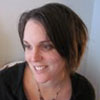Resilience: The Theme of Alumna and Blind Art Therapist Jamie Wasson’s Career and Artwork
July 29, 2013
 “I kind of see life like an impressionist painting,” said Creative Arts Therapies alumna Jamie Wasson, who is legally blind.
“I kind of see life like an impressionist painting,” said Creative Arts Therapies alumna Jamie Wasson, who is legally blind.
Wasson has worked as an art therapist at an outpatient clinic in Center City for seven years, helping children and families who have dealt with a lot of loss, grief and trauma. She also was recently featured in a Philadelphia Inquirer article, specifically about her experience as a student in the Form in Art Program co-run by the Wills Eye Institute and the Philadelphia Museum of Art.
“It is definitely a profession of endurance, which is why I just really believe so strongly in my own self-care,” she said. And self-care is what the Form in Art program gives to Wasson.
Now in its 25th year, Form in Art gives legally blind individuals the education and support to create 2- and 3-dimensional visual art. Most of the people in the program have extremely limited vision or are completely blind. They receive assistance from a group of volunteers who give program members individualized attention and help them set up their materials and discover creative applications of the media.
“It’s such a privilege to be a part of the program,” Wasson said. “It’s also just a great kind of group time to be with others who are experiencing the same life challenges that I do.”
She explained that much of the artwork done in the program is very tactile and done in 3D. People in the program use traditional materials such as clay, papier maché, wood, wire, plaster and terracotta, but they are also challenged to use unconventional items such as pool noodles and aluminum baking pans. Wasson made the artwork featured in the Inquirer by pressing origami paper into a plaster mold.
Since Wasson has usable vision, she is also able to create art in 2D. While she draws inspiration from the visual observations of the things happening around her, most of her work comes from her feelings and philosophy on life.
“Art is this great vehicle to communicate ideas that are happening inside of me that I’m trying to sort out and organize, as well as things that I’m observing around me,” she said. She explained that her work is very autobiographical and shows her journey through obstacles and overcoming challenges. A lot of her work shows forms coming out of the dark into the light and “what hope really means.” She uses both texture and color to show this theme with rough to smooth, dark to light or little to big contrasts.
“I definitely think that the [therapy] work that I do is very compassion-driven,” she explained. “Seeing how people can be in these very dark places but then also really overcome obstacles, and the resilience that I definitely believe we all have inside of us, that’s what inspired me to become a therapist as well as what keeps me in the field. A lot of my artwork, I would say about 90% of it, is about that kind of resilience.”
And this resilience is what she wants her patients to build. Most of the clients Wasson sees are young people ages 4-20 who are in the foster system or have been recently adopted. She teaches the children how to use art as a way for them to find words for what they’ve experienced or what they’re feeling inside. “The reality and the resilience that they have is reflected in the painting.”
Wasson has a few clients that struggle with the reality of home. Distress is extremely disruptive to their daily lives and relationships. Sometimes she does projects with the kids where they build houses and talk about how walls can benefit or restrict a person. She uses this exercise to help them find healthy ways of developing their identity. “Sometimes it can be less about the specific thing that they’re doing in the art and more about just the story that they’re telling through it,” Wasson explained.
Wasson talks to each of her clients about her visual impairments; her blindness has not been an issue with any of them. Some of them have too much trauma on their plate that they focus on themselves and forget about her blindness; others are fascinated by it and ask her many questions about how it affects her life. When she gets into these discussions with patients she says, “We all have really difficult things that we deal with. The question is, what are we going to do about it?”
Wasson has sold several of the artworks she created in the Form in Art program.
“I am proud to be a Drexel alumna, that’s for sure,” Wasson said. “The Creative Arts Therapies Program is such a fantastic, superb program that I definitely felt prepared, and still feel prepared, to do this work. I just have to make sure to take care of myself along the way,” she concluded.